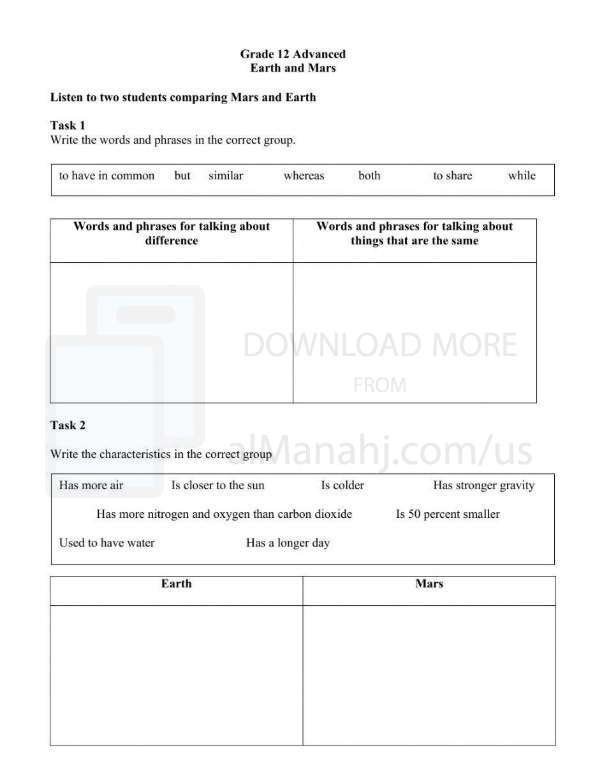| You are here: Almanahj Website ⇒ American curriculum ⇒ 12th Grade ⇒ Geology ⇒ Term 1 | ||
|---|---|---|
Worksheet about Earth and Mars | ||
|---|---|---|
| Subject: Geology | ||
| 12th Grade | ||
| Term 1 | ||
| Year: 2023/2024 | ||
| Size: 186.4KB | ||
| Number of clicks: 183 | ||
| Publish date:November 24, 2023 | ||
| Added by: Eman | ||
| Last download date: 2024-09-13 07:46:44 | By: theodor bhawna2567 | |
| File info: Earth and Mars are two neighboring planets in our solar system. While they share some similarities, they also have significant differences. Here's an overview of Earth and Mars: 1. Size and Structure: - Earth: Earth is the third planet from the Sun and has a diameter of about 12,742 kilometers. It has a layered structure consisting of a solid inner core, a liquid outer core, a solid mantle, and a thin rocky crust. - Mars: Mars is the fourth planet from the Sun and has a diameter of about 6,779 kilometers, roughly half the size of Earth. It also has a layered structure with a solid inner core, a liquid outer core, a rocky mantle, and a thin crust. 2. Atmosphere: - Earth: Earth has a thick atmosphere primarily composed of nitrogen (78%) and oxygen (21%) with trace amounts of other gases. The atmosphere plays a crucial role in regulating temperature, protecting against harmful radiation, and supporting life. - Mars: Mars has a much thinner atmosphere compared to Earth. Its atmosphere is mainly composed of carbon dioxide (95.3%) with traces of nitrogen, argon, and oxygen. The thin atmosphere provides little protection from solar radiation and results in significantly colder temperatures. 3. Climate and Surface Conditions: - Earth: Earth has a diverse climate system with a range of temperature zones, weather patterns, and precipitation. It has large bodies of liquid water, a variety of landforms, and extensive vegetation cover. Earth's surface includes continents, oceans, mountains, deserts, and other ecosystems. - Mars: Mars has a cold and dry climate. The average temperature on Mars is much colder than Earth, averaging around -63 degrees Celsius (-81 degrees Fahrenheit). Liquid water cannot exist on its surface due to the low atmospheric pressure, but there are indications of frozen water in the polar ice caps and subsurface. 4. Habitability and Life: - Earth: Earth is the only known planet to support life. It has a rich diversity of organisms, including complex life forms. The presence of liquid water, a stable climate, and a protective atmosphere have been crucial for the development and sustenance of life on Earth. - Mars: Mars is a subject of scientific interest for potential past or present habitability. While liquid water existed in the past, the current harsh conditions make it challenging for life as we know it to thrive on the planet's surface. However, future missions seek to explore the possibility of microbial life or the potential for human habitation. 5. Exploration and Missions: - Earth: Earth has been extensively explored by various spacecraft, satellites, and human missions. It is home to a vibrant space exploration program by different nations, including robotic missions, satellite observations, and the International Space Station (ISS). - Mars: Mars has been the focus of numerous missions aimed at studying its geology, atmosphere, and the potential for past or present life. Several orbiters, landers, and rovers, including NASA's Perseverance rover, have provided valuable insights into the planet's surface and history. While Earth is currently the only known planet to support life, Mars presents a fascinating opportunity for scientific exploration and potential future colonization efforts. Understanding the similarities and differences between these two planets helps us further our knowledge of the solar system and the possibilities of extraterrestrial environments. | ||
| Downloading link Worksheet about Earth and Mars |
|---|
|
1700814037.pdf
The file is being prepared for download
|
| File images |
|---|
 |